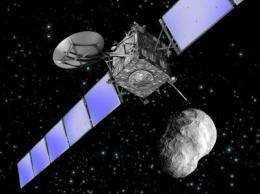Rosetta's blind date with asteroid Lutetia

ESA's comet-chaser Rosetta is heading for a blind date with asteroid Lutetia. Rosetta does not yet know what Lutetia looks like but beautiful or otherwise the two will meet on 10 July.
Like many first dates, Rosetta will meet Lutetia on a Saturday night, flying to within 3200 km of the space rock. Rosetta started taking navigational sightings of Lutetia at the end of May so that ground controllers can determine any course corrections required to achieve their intended flyby distance.
The close pass will allow around 2 hours of good imaging. The spacecraft will instantly begin beaming the data back to Earth and the first pictures will be released later that evening.
Rosetta flew by asteroid Steins in 2008 and other space missions have encountered a handful of asteroids. Each asteroid has proven to be an individual and Lutetia is expected to continue the trend.
For a start, no one knows what it looks like. Orbiting in the main belt of asteroids between Mars and Jupiter, it appears as a single point of light to ground telescopes. The continuous variation in its brightness makes it clear that Lutetia is rotating and has an uneven surface. These observations allow astronomers to estimate its shape and size, but their determinations all differ.
Initially it was thought that Lutetia is around 95 km in diameter but only mildly elliptical. A more recent estimate suggests 134 km, with a pronounced elongation. Rosetta will tell us for certain and will also investigate the composition of the asteroid, wherein lies another mystery.
By any measure, Lutetia is quite large. Planetary scientists believe that it is a primitive asteroid left on the shelf for billions of years because no planet consumed it as the Solar System formed. Indeed, most measurements appear to back this picture, making the asteroid out to be a 'C-type', which contains primitive compounds of carbon.
However, some measurements suggest that Lutetia is an 'M-type', which could mean there are metals in its surface. "If Lutetia is a metallic asteroid then we have found a real winner," says Rita Schulz, ESA Rosetta Project Scientist.
That is because although metallic asteroids do exist, they are thought to be fragments of the metallic core of larger asteroids that have since been shattered into pieces. If Lutetia is made of metal or even contains large amounts of metal, Dr Schulz says that the traditional asteroid classification scheme will need rethinking. "C-class asteroids should not have metals on their surfaces," she says.
Asteroid science stands to gain once this observational conundrum is resolved because Rosetta's data will provide a valuable collection of 'ground truths' that can be used to resolve conflicting ground-based observations not just for Lutetia but for other asteroids as well.
For 36 hours around the moment of closest approach, Rosetta will be in almost continuous contact with the ground. The only breaks will come as Earth rotates and engineers have to switch from one tracking station to another.
Good contact is essential because the uncertainties in the asteroid's position and shape may demand last minute fine-tuning to keep it centred in Rosetta's instruments during the flyby. "The skeleton of the operation is in place, and we have the ability to update our plans at any time," says Andrea Accomazzo, ESA Rosetta Spacecraft Operations Manager.
More information: Stay in touch with the flyby as it happens by visiting the Rosetta blog at webservices.esa.int/blog/blog/5/
Provided by European Space Agency




















